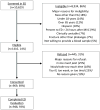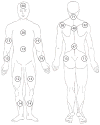Pain distribution and predictors of widespread pain in the immediate aftermath of motor vehicle collision
- PMID: 23335385
- PMCID: PMC3644322
- DOI: 10.1002/j.1532-2149.2013.00285.x
Pain distribution and predictors of widespread pain in the immediate aftermath of motor vehicle collision
Abstract
Background: Musculoskeletal pain is common after motor vehicle collision (MVC). The study objective was to evaluate distribution of pain and predictors of widespread musculoskeletal pain in the early aftermath (within 48 h) of collision.
Methods: European American adults aged 18-65 years presenting to the emergency department (ED) after collision who were discharged to home after evaluation were eligible. Evaluation included an assessment of reported pre-collision psychological characteristics, crash characteristics, current pain severity and location, and current psychological symptoms. Adjusted risk ratios were estimated using generalized linear models.
Results: Among 890 participants included in the study, 589/890 (66%) had pain in three or more regions, and 192/890 (22%) had widespread musculoskeletal pain (pain in seven or more regions). In adjusted analyses, the presence of widespread pain was strongly associated with depressive and somatic symptoms prior to collision, pain catastrophizing, and acute psychological symptoms, and was not associated with most collision characteristics (road speed limit, extent of vehicle damage, collision type, driver vs. passenger, airbag deployment). The reported number of body regions that struck an object during the collision was associated with both reported pre-collision depressive symptoms and with widespread pain.
Conclusion: More than one in five individuals presenting to the ED in the hours after MVC have widespread pain. Widespread pain is strongly associated with patient characteristics known to be modulated by supraspinal mechanisms, suggesting that stress-induced hyperalgesia may influence acute widespread pain after collision.
© 2013 European Federation of International Association for the Study of Pain Chapters.
Figures



Similar articles
-
Incidence and predictors of neck and widespread pain after motor vehicle collision among US litigants and nonlitigants.Pain. 2014 Feb;155(2):309-321. doi: 10.1016/j.pain.2013.10.016. Epub 2013 Oct 18. Pain. 2014. PMID: 24145211 Free PMC article.
-
Persistent and Widespread Pain Among African-Americans Six Weeks after MVC: Emergency Department-based Cohort Study.West J Emerg Med. 2020 Dec 16;22(2):139-147. doi: 10.5811/westjem.2020.8.47450. West J Emerg Med. 2020. PMID: 33856293 Free PMC article.
-
Pain, distress, and anticipated recovery for older versus younger emergency department patients after motor vehicle collision.BMC Emerg Med. 2014 Dec 30;14:25. doi: 10.1186/s12873-014-0025-y. BMC Emerg Med. 2014. PMID: 25547869 Free PMC article.
-
Chronic widespread pain after motor vehicle collision typically occurs through immediate development and nonrecovery: results of an emergency department-based cohort study.Pain. 2016 Feb;157(2):438-444. doi: 10.1097/j.pain.0000000000000388. Pain. 2016. PMID: 26808013 Free PMC article.
-
The development of persistent pain and psychological morbidity after motor vehicle collision: integrating the potential role of stress response systems into a biopsychosocial model.Psychosom Med. 2005 Sep-Oct;67(5):783-90. doi: 10.1097/01.psy.0000181276.49204.bb. Psychosom Med. 2005. PMID: 16204439 Review.
Cited by
-
Associations of Psychologic Factors with Multiple Chronic Overlapping Pain Conditions.J Oral Facial Pain Headache. 2020;34(Suppl):s85-s100. doi: 10.11607/ofph.2584. J Oral Facial Pain Headache. 2020. PMID: 32975543 Free PMC article.
-
Incidence and predictors of neck and widespread pain after motor vehicle collision among US litigants and nonlitigants.Pain. 2014 Feb;155(2):309-321. doi: 10.1016/j.pain.2013.10.016. Epub 2013 Oct 18. Pain. 2014. PMID: 24145211 Free PMC article.
-
Further evidence that peritraumatic 17β-estradiol levels influence chronic posttraumatic pain outcomes in women, data from both humans and animals.Pain. 2025 Apr 1;166(4):812-823. doi: 10.1097/j.pain.0000000000003408. Epub 2024 Sep 13. Pain. 2025. PMID: 39287098
-
Positive, but not negative, treatment outcome expectancies mediate the relation between depressive symptoms and treatment-related pain reduction.J Behav Med. 2023 Jun;46(3):489-498. doi: 10.1007/s10865-022-00380-9. Epub 2022 Nov 28. J Behav Med. 2023. PMID: 36441487
-
Persistent and Widespread Pain Among African-Americans Six Weeks after MVC: Emergency Department-based Cohort Study.West J Emerg Med. 2020 Dec 16;22(2):139-147. doi: 10.5811/westjem.2020.8.47450. West J Emerg Med. 2020. PMID: 33856293 Free PMC article.
References
-
- Baker SP, O’Neill B, Haddon W, Long WB. The injury severity score: a method for describing patients with multiple injuries and evaluating emergency care. J Trauma. 1974;14:187–196. - PubMed
-
- Bedard M, Guyatt GH, Stones MJ, Hirdes JP. The independent contribution of driver, crash, and vehicle characteristics to driver fatalities. Accid Anal Prev. 2002;34:717–727. - PubMed
-
- Berglund A, Alfredsson L, Jensen I, Cassidy JD, Nygren A. The association between exposure to a rear-end collision and future health complaints. J Clin Epidemiol. 2001;54:851–856. - PubMed
-
- Brunet A, Weiss DS, Metzler TJ, Best SR, Neylan TC, Rogers C, Fagan J, Marmar CR. The Peritraumatic Distress Inventory: a proposed measure of PTSD criterion A2. Am J Psychiatry. 2001;158:1480–1485. - PubMed
-
- Buskila D, Neumann L, Vaisberg G, Alkalay D, Wolfe F. Increased rates of fibromyalgia following cervical spine injury. A controlled study of 161 cases of traumatic injury. Arthritis Rheum. 1997;40:446–452. - PubMed
Publication types
MeSH terms
Grants and funding
LinkOut - more resources
Full Text Sources
Other Literature Sources
Medical

